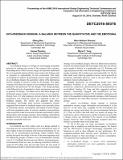| dc.contributor.author | Shaukat, Mian Mobeen | |
| dc.contributor.author | Elantary, Asmaa | |
| dc.contributor.author | Bao, Qifang | |
| dc.contributor.author | Yang, Maria C. | |
| dc.date.accessioned | 2019-01-14T18:51:40Z | |
| dc.date.available | 2019-01-14T18:51:40Z | |
| dc.date.issued | 2016-08 | |
| dc.identifier.isbn | 978-0-7918-5019-0 | |
| dc.identifier.uri | http://hdl.handle.net/1721.1/120031 | |
| dc.description.abstract | Eco-feedback design is a strategy for encouraging sustainable behavior by making users aware of the resources they consume. Reminding users of their resource usage can help them understand the environmental impacts of their actions and evoke feelings such as sympathy or responsibility for the environment. This study investigated two aspects of presenting resource usage information in eco-feedback designs: the quantitative clarity of the information, and the strength of emotion evoked by the designs. This paper examines how these two aspects of eco-feedback influence users' perception and preference for the designs. Four design prompts with different levels of quantitative clarity and emotion were used to generate 16 designs. An online survey with these designs was distributed among students at four universities in two countries. Results from 216 valid responses showed evidence that both the quantitative and emotional aspects are important to the ecofeedback designs. The survey also gathered data about respondents' knowledge about resource consumption. Results suggested that students in technical majors were generally better at estimating resource consumption, and tended to prefer designs with more quantitative data. In contrast, students in non-technical majors generally made less accurate estimates and tended to prefer designs that evoke stronger emotions. These findings could inform designers on how to make more effective eco-feedback designs to promote sustainable behaviors. | en_US |
| dc.description.sponsorship | King Fahd University of Petroleum & Minerals (through the Center for Clean Water and Clean Energy at MIT and KFUPM) | en_US |
| dc.publisher | ASME International | en_US |
| dc.relation.isversionof | http://dx.doi.org/10.1115/DETC2016-59376 | en_US |
| dc.rights | Article is made available in accordance with the publisher's policy and may be subject to US copyright law. Please refer to the publisher's site for terms of use. | en_US |
| dc.source | ASME | en_US |
| dc.title | Eco-Feedback Designs: A Balance Between the Quantitative and the Emotional | en_US |
| dc.type | Article | en_US |
| dc.identifier.citation | Bao, Qifang, Mian Mobeen Shaukat, Asmaa Elantary, and Maria C. Yang. “Eco-Feedback Designs: A Balance Between the Quantitative and the Emotional.” Volume 7: 28th International Conference on Design Theory and Methodology (August 21, 2016). | en_US |
| dc.contributor.department | Massachusetts Institute of Technology. Department of Mechanical Engineering | en_US |
| dc.contributor.department | Massachusetts Institute of Technology. Institute for Data, Systems, and Society | en_US |
| dc.contributor.mitauthor | Bao, Qifang | |
| dc.contributor.mitauthor | Yang, Maria | |
| dc.relation.journal | Volume 7: 28th International Conference on Design Theory and Methodology | en_US |
| dc.eprint.version | Final published version | en_US |
| dc.type.uri | http://purl.org/eprint/type/ConferencePaper | en_US |
| eprint.status | http://purl.org/eprint/status/NonPeerReviewed | en_US |
| dc.date.updated | 2019-01-14T18:32:42Z | |
| dspace.orderedauthors | Bao, Qifang; Shaukat, Mian Mobeen; Elantary, Asmaa; Yang, Maria C. | en_US |
| dspace.embargo.terms | N | en_US |
| dc.identifier.orcid | https://orcid.org/0000-0003-0663-8438 | |
| dc.identifier.orcid | https://orcid.org/0000-0002-7776-3423 | |
| mit.license | PUBLISHER_POLICY | en_US |
